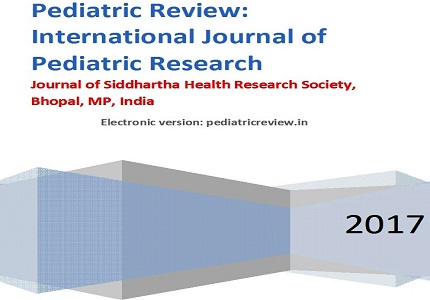Study offeatures associated with death in children with severe malaria at a tertiary care hospital in Western India
Abstract
Background: India contributes significantly to world malaria load and it accounts for 6% of the total malaria cases, 49 % of the vivax malaria cases and 51% of vivax malaria deaths across the world. There is scarce informationabout predictors of mortality in children with severe malaria from India.
Objectives: To study the factors associated with death in children with severe malaria at a tertiary care hospital in western India.
Methods: A retrospective study was conducted at the pediatric department of a tertiary care hospital (Mumbai) over a three-year period. Demographic data, clinical and laboratory findings of patients with slide-positive malaria were collected from hospital records. Children with any one of the manifestations of severe malariaas per WHO protocol were enrolled in the study. Univariate and multiple regression analysis were usedto identify major predictors of death like: 1) Severe Anemia, 2) Respiratory distress, 3) Multiple generalized convulsions, 4) Spontaneous bleeding, 5) Hemoglobinuria, 6) Impaired consciousness, 7) Jaundice, 8) Prostration, 9) Circulatory Collapse, 10) Pulmonary oedema.
Results: Sixty-four subjectswere enrolled in the study. The case fatality rate was 20%. Thirty five (55%) patients presented with more than one predictor. The mortality rate was consistently high in patients having more than one predictor. Univariate analysis identified spontaneous bleeding (35% mortality)and multiple convulsions (60 % mortality) as major predictors of death. Multivariate analysis showed no single factor emerged as a significant predictor of death.
Conclusions: Spontaneous bleeding and multiple convulsions emerged as significant predictors of death during Univariate analysis. However no single factor emerged as significant predictor during multivariate analysis.
Downloads
References
2. Ministry of Health and Family Welfare. National vector borne disease control program. Malaria. [Internet]. 2017. Available from: http://nvbdcp.gov.in [last accessed on 8 July 2017].
3. Tripathy R, Parida S, Das L, Mishra D, Tripathy D, Das M, Chen H, Maguire J and Panigrahi P. Clinical Manifestations and Predictors of Severe Malaria in Indian Children. Pediatrics. 2007; 120(3): 454-60.
4. Marsh K, Forster D, Waruiru C, Mwangi I, Winstanley M, Marsh V, Newton C, Winstanley P, Warn P, Peshu N, et al. Indicators of life-threatening malaria in African children. N Engl J Med. 1995 May 25;332(21):1399-404. [PubMed]
5. Seidlein LV, Olaosebikan R, Hendriksen IC, Lee SJ, Adedoyin OT, Agbenyega T et al. Predicting the Clinical Outcome of Severe Falciparum Malaria in African Children: Findings From a Large Randomized Trial. Clinical Infectious Diseases 2012; 54(8): 1080-90.
6. Mockenhaupt FP, Ehrhardt S, Burkhardt J, Bosomtwe SY, Laryea S, Anemana SD, Otchwemah RN, Cramer JP, Dietz E, Gellert S, Bienzle U. Manifestation and outcome of severe malaria in children in northern Ghana. Am J Trop Med Hyg. 2004 Aug;71(2):167-72. [PubMed]
7. Al-Taiar A, Jaffar S, Assabri A, Al-Habori M, Azazy A, Al-Mahdi N, Ameen K, Greenwood BM, Whitty CJ. Severe malaria in children in Yemen: two site observational study. BMJ. 2006 Oct 21;333(7573):827.
8. Kumar A, Valecha N, Jain T, Dash AP. Burden of malaria in India: retrospective and prospective view. Am J Trop Med Hyg. 2007 Dec;77(6 Suppl):69-78. [PubMed]
9. World Health Organization: Severe Falciparum Malaria. World Health Organization, communicable disease cluster. Trans R Soc Trop Med Hyg 2000; 94(suppl 1): S1- S90. [PubMed]
10. Sharma RK, Thakor HG, Saha KB, Sonal GS, Dhariwal AC, Singh N. Malaria situation in India with special reference to tribal areas. Indian J Med Res. 2015 May;141(5):537-45. [PubMed]
11. Idro R, Ndiritu M, Ogutu B, Mithwani S, Maitland K, Berkley J, Crawley J, Fegan G, Bauni E, Peshu N, Marsh K, Neville B, Newton C. Burden, features, and outcome of neurological involvement in acute falciparum malaria in Kenyan children. JAMA. 2007 May 23;297(20):2232-40. [PubMed]
12. Olanrewaju WI, Johnson AW. Malaria in children in Ilorin, Nigeria. East Afr Med J. 2001 Mar;78(3):131-4. [PubMed]
13. Maitland K, Levin M, English M, Mithwani S, Peshu N, Marsh K, Newton CR. Severe P. falciparum malaria in Kenyan children: evidence for hypovolaemia. QJM. 2003 Jun;96(6):427-34. [PubMed]
14. Korenromp EL, Armstrong-Schellenberg JR, Williams BG, Nahlen BL and, Snow RW. Impact of malaria control on childhood anemia in Africa- a quantitative review. Trop Med Int Health 2004; 9(10):1050–65. [PubMed]
15. Obonyo CO, Steyerberg EW, Oloo AJ, Habbema JD. Blood transfusions for severe malaria-related anemia in Africa: a decision analysis. Am J Trop Med Hyg. 1998 Nov;59(5):808-12. [PubMed]
16. Yadav D, Chandra J, Aneja S, Kumar V, Kumar P, Dutta AK. Changing profile of severe malaria in north Indian children. Indian J Pediatr. 2012 Apr;79(4):483-7. doi: 10.1007/s12098-011-0603-x. Epub 2011 Nov 18.

Copyright (c) 2017 Author (s). Published by Siddharth Health Research and Social Welfare Society

This work is licensed under a Creative Commons Attribution 4.0 International License.


 OAI - Open Archives Initiative
OAI - Open Archives Initiative


